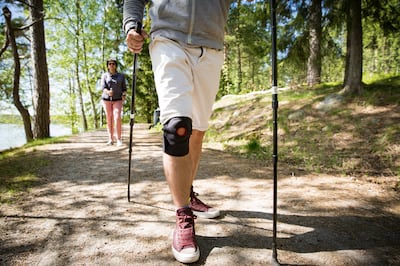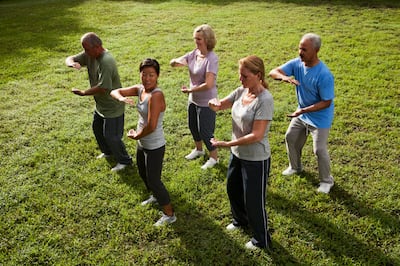Walking is just not enough, according to a new review which reveals a major disconnect between the exercise people need and what they actually do.
Those who thought 10,000 steps a day or a brisk daily trudge from a further bus stop meant they were doing enough to stay fit and healthy have got it wrong, says the English report. People should also all be doing tai chi, weight lifting or ballroom dancing – although carrying home heavy shopping bags might do the trick.
Aerobic exercise, such as walking or gardening, is good for the heart and improves the circulation. Public Health England’s (PHE) review said that muscle and bone strengthening and balance activities are also vital for health and future wellbeing, but they are neglected.
In older adults, poor muscle strength increased the risk of a fall by 76 per cent, PHE said. Those who have already had a fall are three times more likely to fall again. Strengthening and balance activities not only help prevent falls, but also help improve mood, sleeping patterns, increase energy levels and reduce the risk of an early death.
"People's understanding of walking more and doing aerobic activity, keeping up the heart rate, has grown, but the need for us all to do two sessions of strength and balance exercise a week has been the Cinderella of public health advice," said Louise Ansari from the centre for ageing better, a charity set up with lottery funding a few years ago which co-wrote the review with PHE.
In 2011, the UK’s four chief medical officers issued guidance containing three pieces of exercise and activity advice, but only some of it has been well followed. Walking has become increasingly popular. But fewer people have taken on board the need to stand more and sit less and muscle strengthening and balance have been largely forgotten.
According to the Irish government’s national physical activity plan – published in 2016 – all adults should get at least 30 minutes of moderate activity, five days a week. The plan said children and young people should be active to a moderate to vigorous level for at least 60 minutes a day – with this including muscle-strengthening, flexibility and bone-strengthening exercises three times a week.

Muscles tend to be at their peak in our 30s, said Ansari, and the muscle tone is going by the time we reach 40 unless we actively work on it. The best forms of exercise, according to the review of evidence, are ball games, racket sports, dance, Nordic walking and resistance training – usually training with weights, but including body weight exercises which can be performed anywhere.
These exercise both arms and legs, strengthening muscles and helping us keep our balance. In Nordic walking, for instance, two poles are used.
Ansari said the type of exercise required depends on a person’s fitness. “If you are a reasonably fit adult and you do walking, you should also do yoga or tai chi or racket sports or resistance training which could be in a structured exercise class. You can do two long sessions a week. I do an hour and a quarter of tai chi every week. That helps with my balance. I should also do something like badminton and circuit or resistance training.”
But exercise doesn’t have to be in a gym, she added. “You can also make sure you go up and down stairs a lot instead of taking the lift. That is resistance training. Your body is providing the resistance. You don’t have to go to the gym. As long as you are feeling the ache in your muscles.”

Dance of all sorts is good for muscles and balance, from folk to salsa to ballroom. “If you don’t feel you can go to a full-on dance class because you are a bit frail, standing on one leg for 30 seconds a day or tai chi are very good.”
Ansari said she doesn’t use a gym. “I don’t go and lift weights, but I make sure I’m carrying shopping home and carrying things around – consciously lifting weight.”
The advice is not just for the elderly. "Alongside aerobic exercise such as brisk walking, all adults should be aiming to do strengthening and balancing activities twice per week," said Dr Alison Tedstone, head of diet, obesity and physical activity at PHE. "On average we're all living longer and this mixture of physical activities will help us stay well in our youth and remain independent as we age."
The evidence review now goes to the four chief medical officers, who will update the guidance next year.
– Guardian













